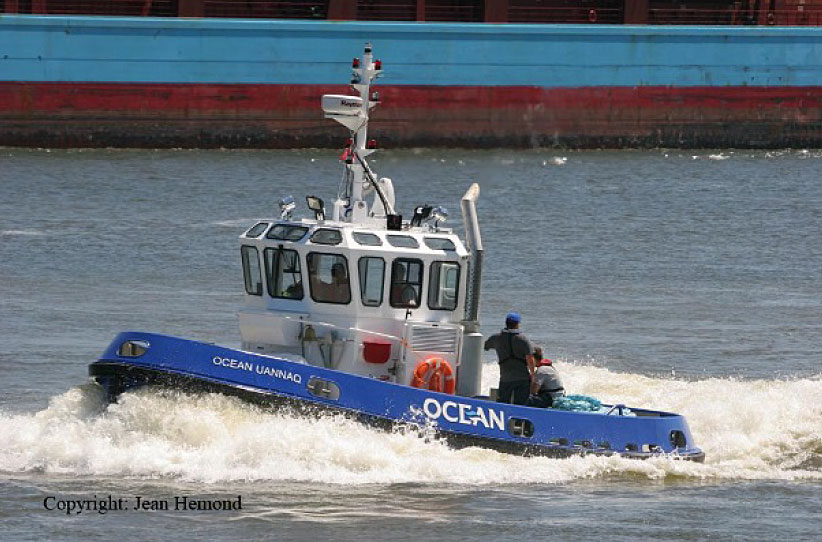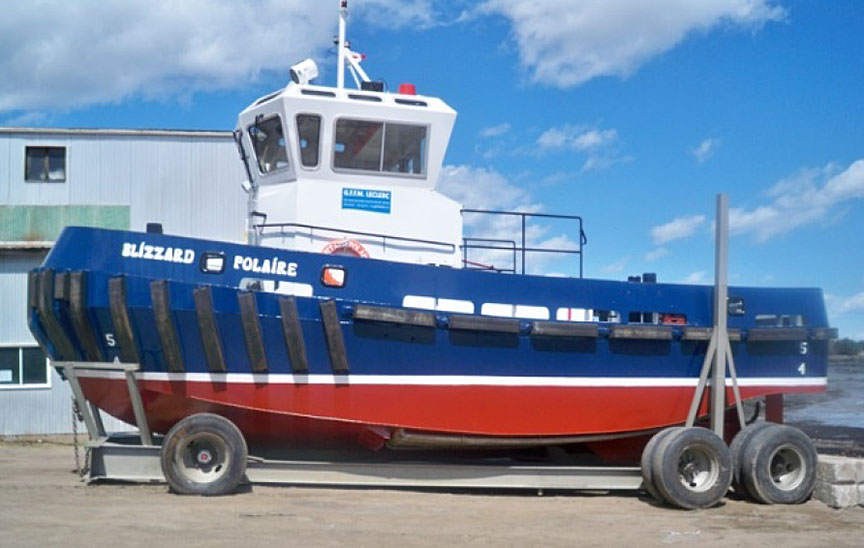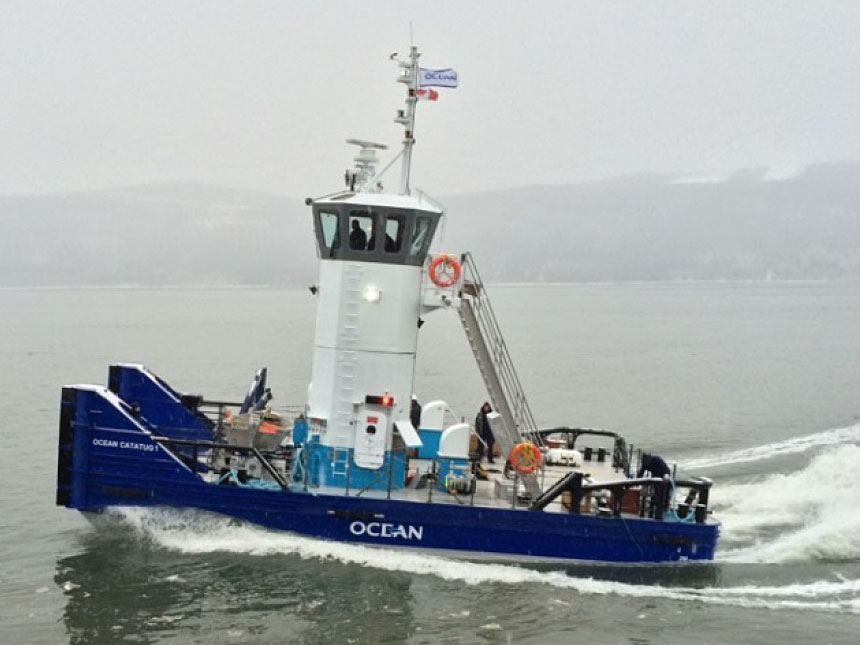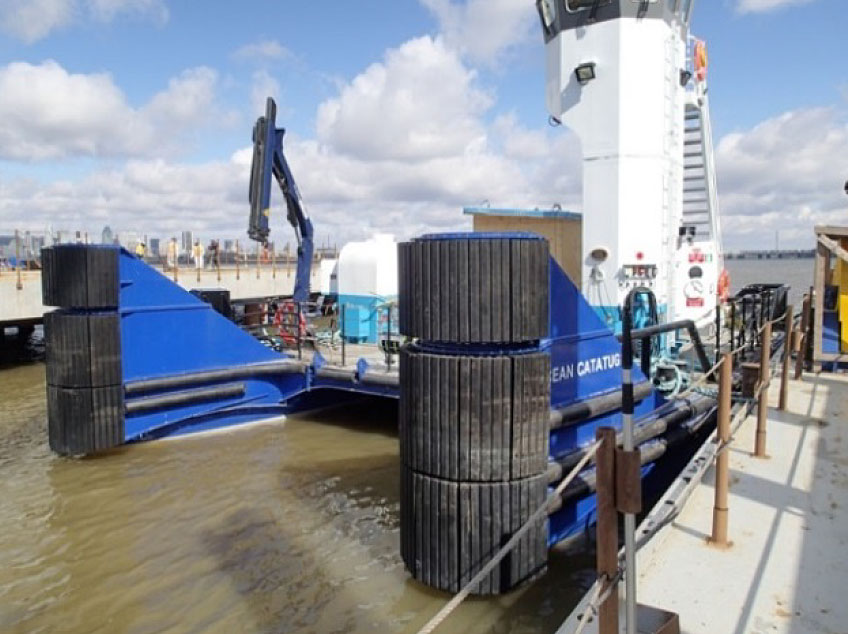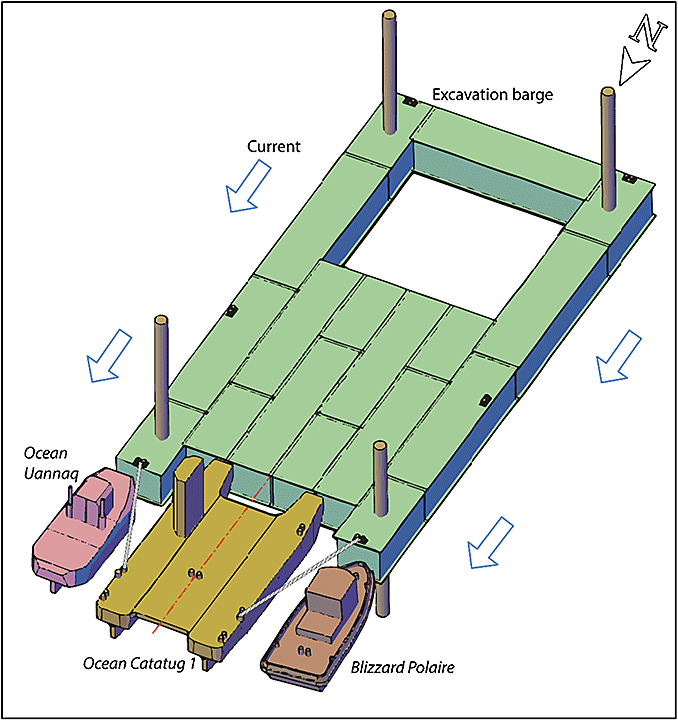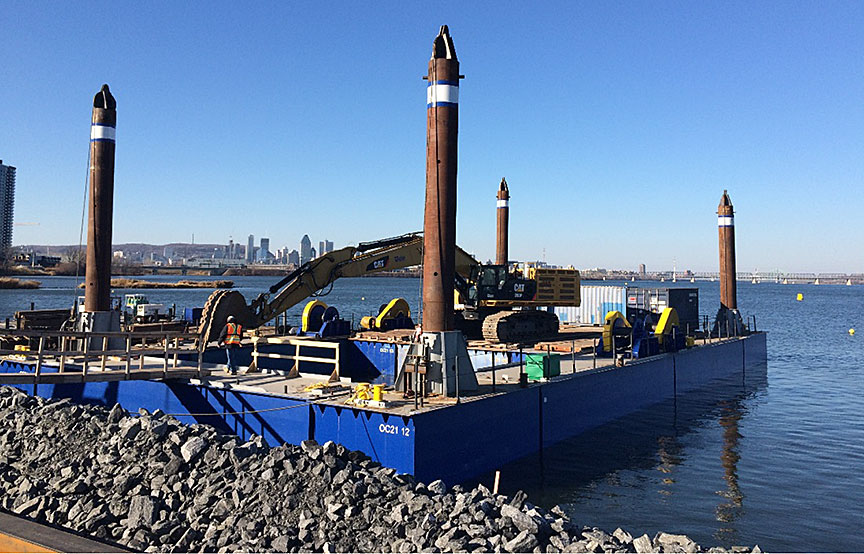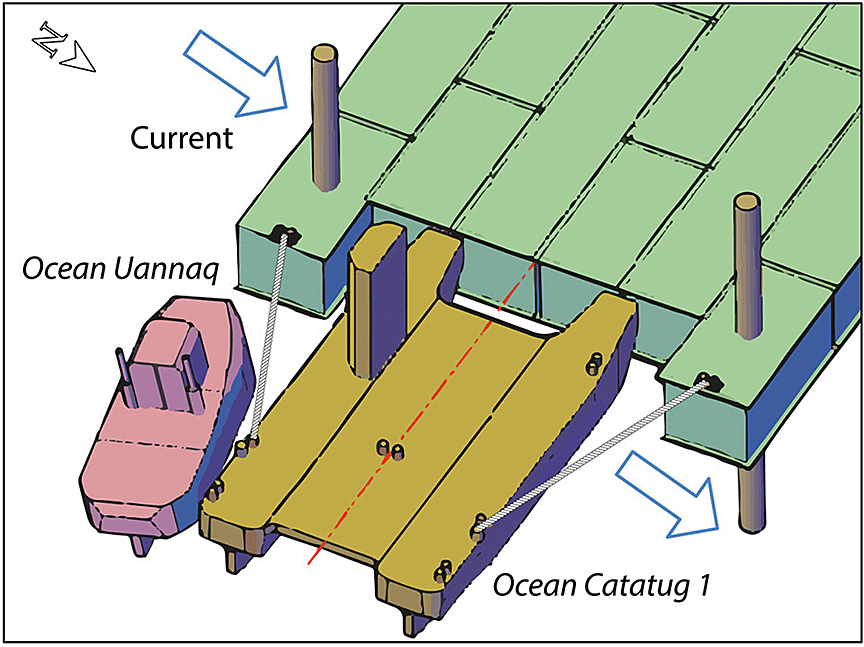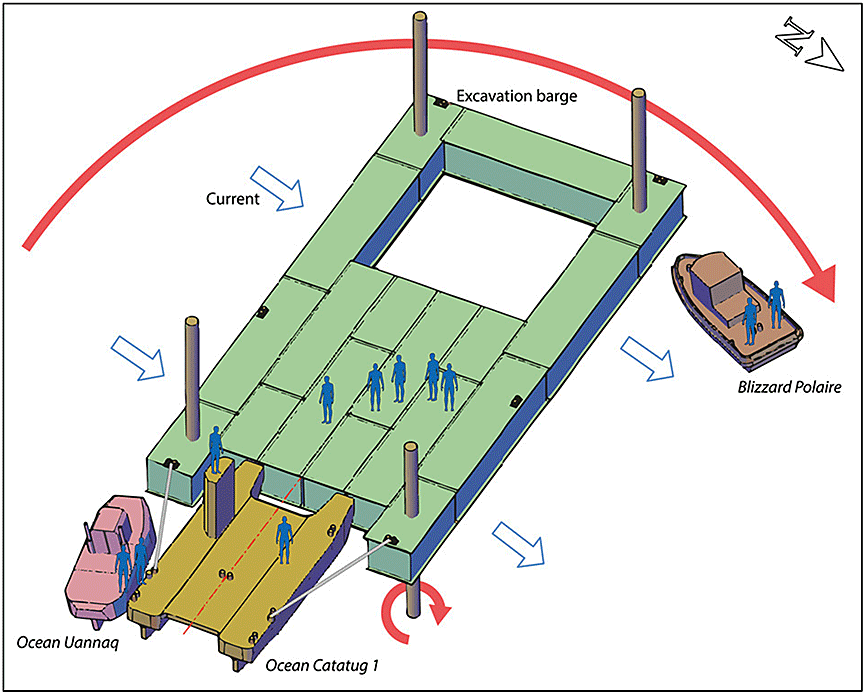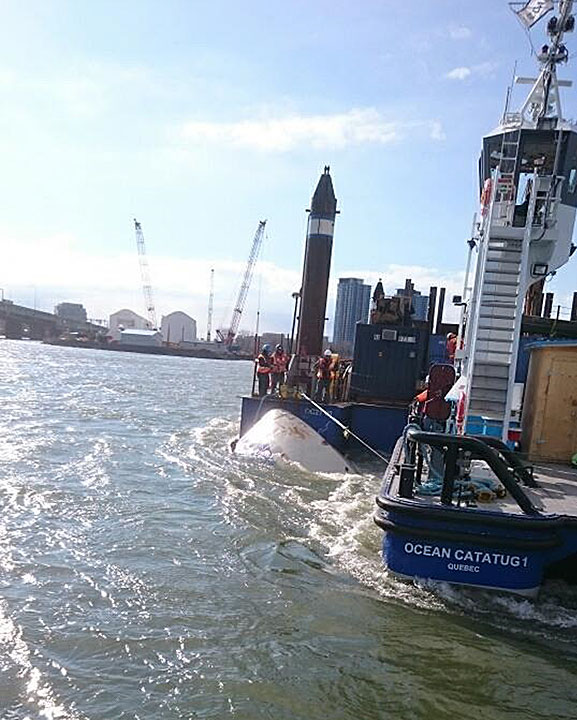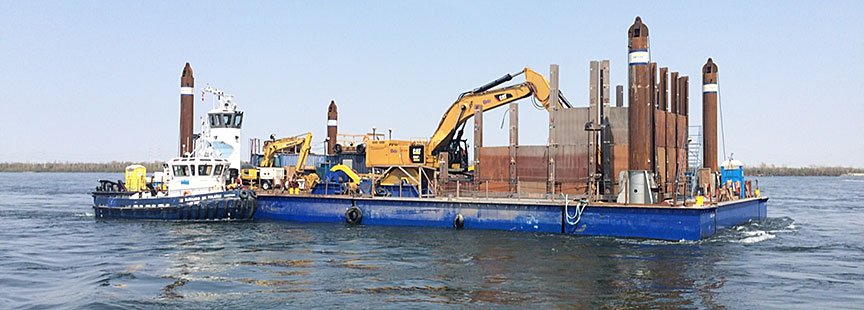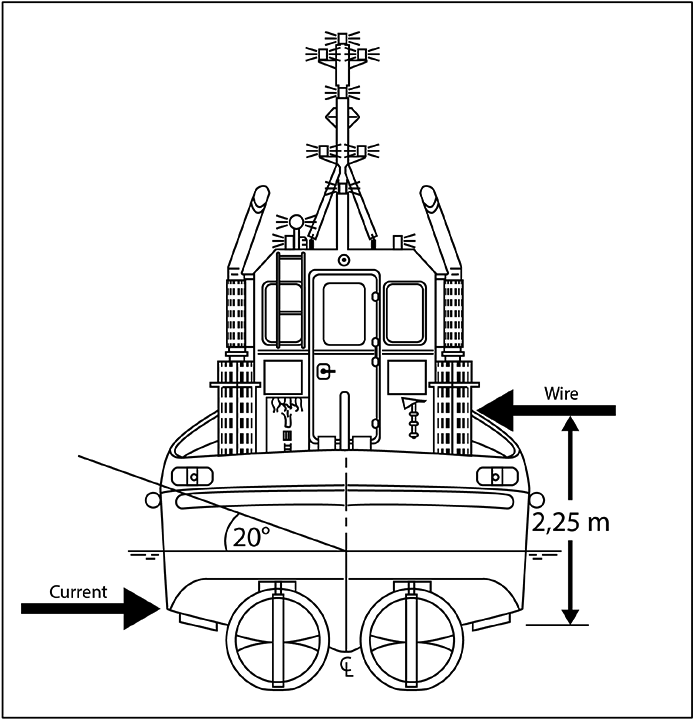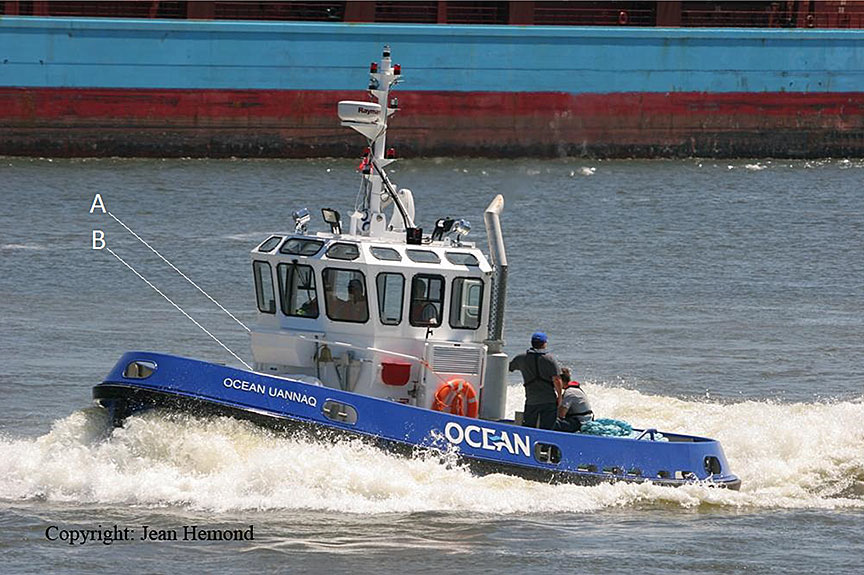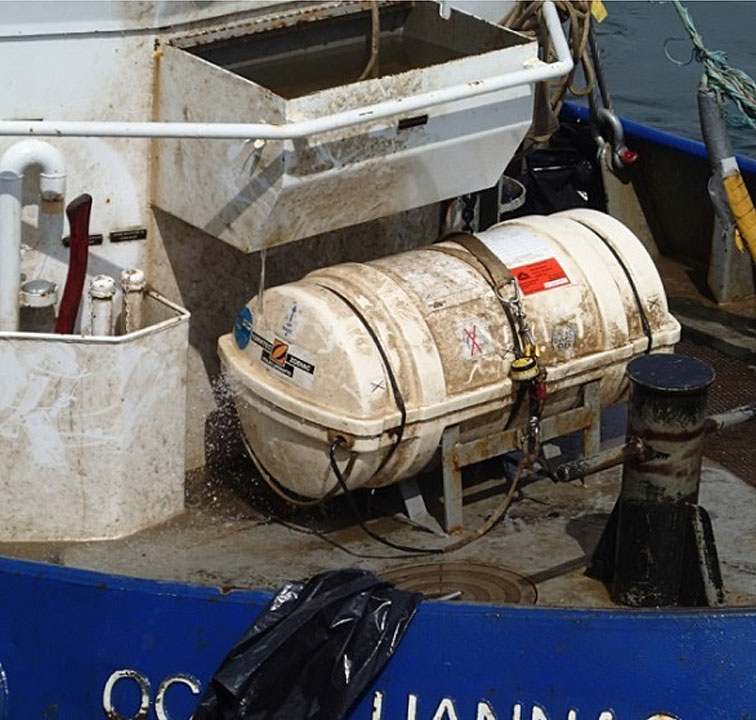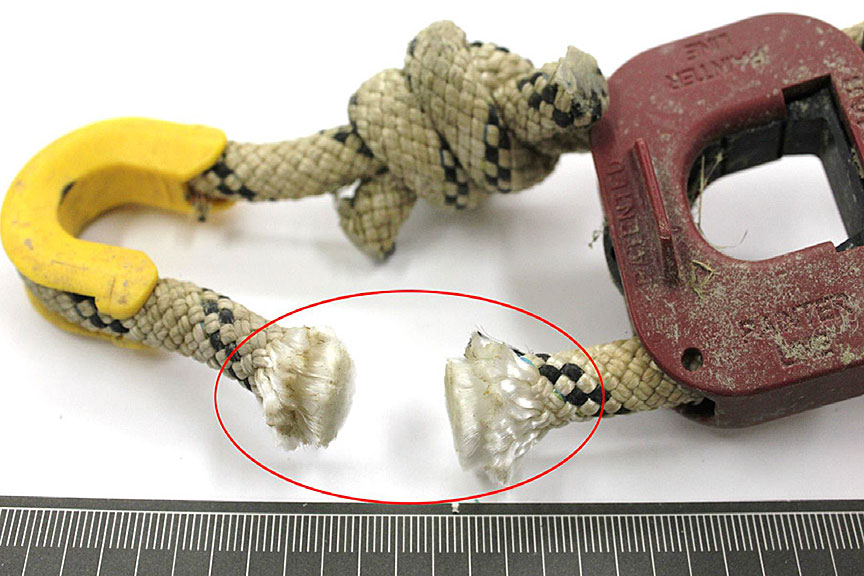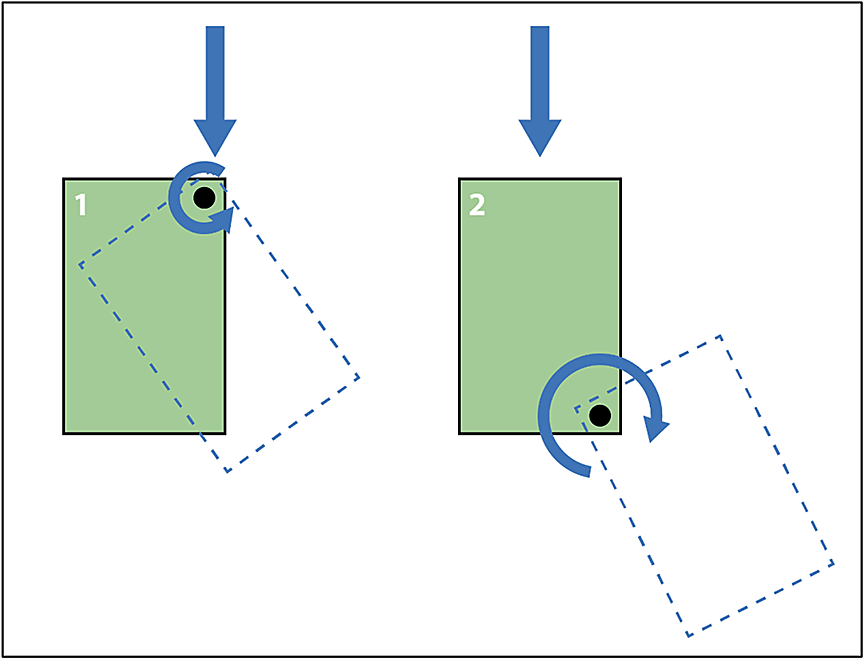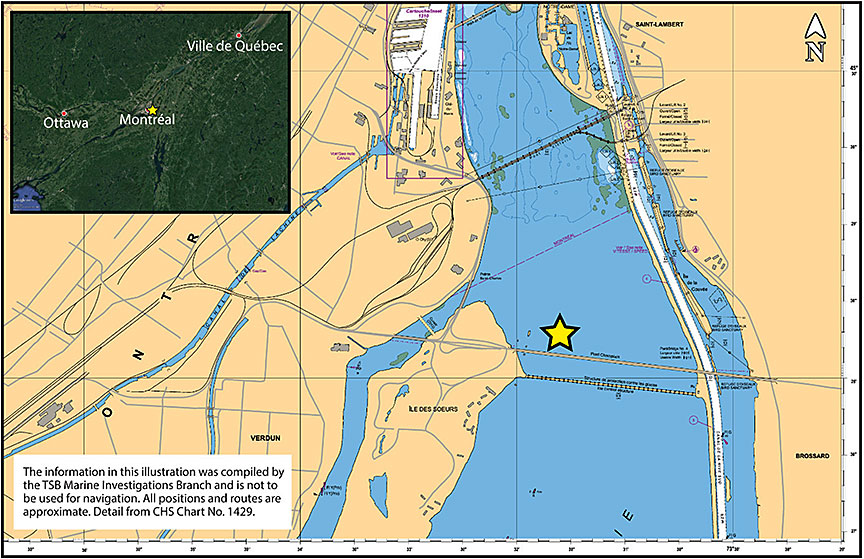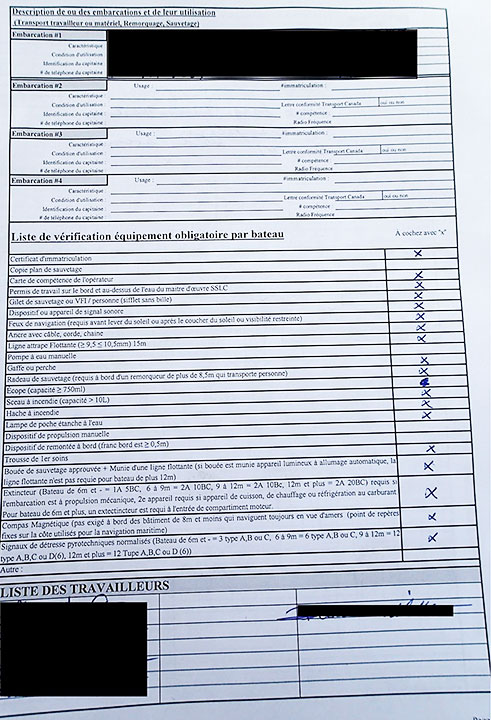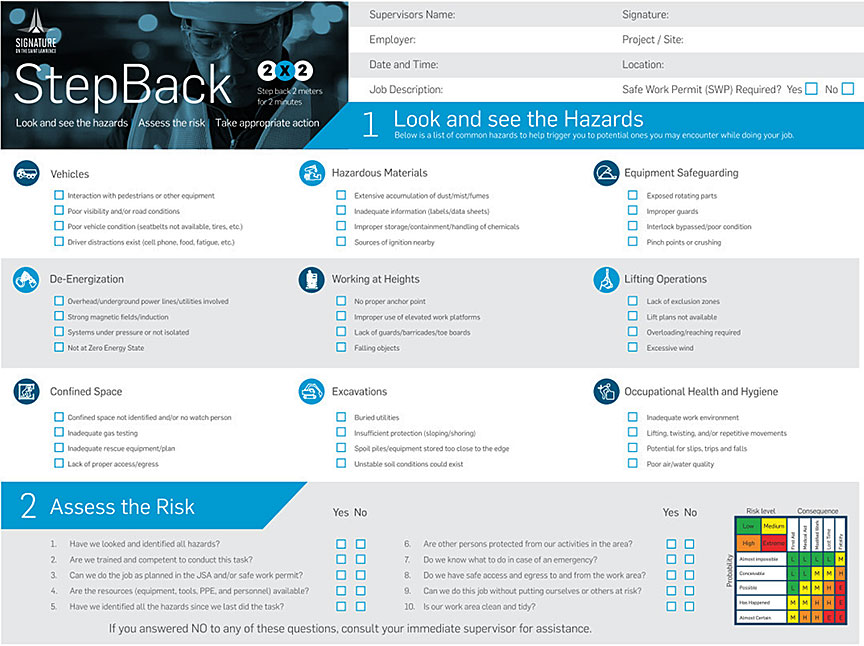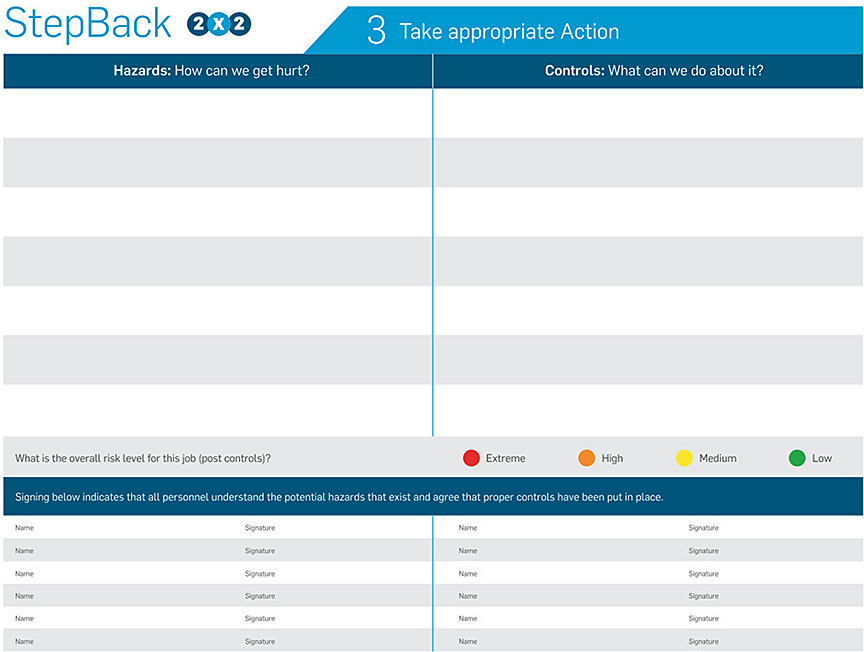Capsizing and sinking
Tug Ocean Uannaq
Champlain Bridge, St. Lawrence River, Montréal, Quebec
The Transportation Safety Board of Canada (TSB) investigated this occurrence for the purpose of advancing transportation safety. It is not the function of the Board to assign fault or determine civil or criminal liability. This report is not created for use in the context of legal, disciplinary or other proceedings. See Ownership and use of content.
Summary
On 01 April 2016, at approximately 1623 Eastern Daylight Time, the tug Ocean Uannaq capsized while attempting to move a barge with 2 other tugs to the Île des Sœurs work quay during construction of the new Champlain Bridge on the St. Lawrence River off Montréal, Quebec. The 2 crew on board abandoned onto another tug, which was alongside the Ocean Uannaq. The Ocean Uannaq later sank at 1850. There were no injuries or pollution. The Ocean Uannaq was raised from the riverbed on 28 May 2016.
This report is also available in English.
1.0 Factual information
1.1 Particulars of the vessels
| Name of vessel | Ocean Uannaq | Blizzard Polaire | Ocean Catatug 1 | Excavation barge |
|---|---|---|---|---|
| Official number | 832576 | C23875QC | 839530 | 17 registered barges temporarily attached together |
| Port of registry | Québec, QC | Québec, QC | Québec, QC | Québec, QC |
| Flag | Canada | Canada | Canada | Canada |
| Type | Tug | Tug/Workboat | Tug | Barge |
| Gross tonnage | 11.55 | 14.99 | 39.66 | N/A |
| Registered length | 9.6 m | 11.30 m | 15.80 m | 38.7 m (total length) |
| Draft at departure | 1.4 m | 1.9 m | 1.2 m | 2.7 m |
| Built | 2008 | 2015 | 2015 | 2015 |
| Propulsion | 2 diesel engines (574 kW) driving twin fixed-pitch ducted propellers | 3 diesel engines (906 kW) driving 3 fixed‑pitch ducted propellers |
2 diesel engines (1067 kW) driving twin fixed‑pitch propellers | Not propelled |
| Crew | 2 | 2 | 2 | 5 |
| Registered owner | 8592802 Canada Inc. | 9065-5283 Québec Inc. | Travaux Maritimes Océan Inc. | 8666164 Canada Inc. |
| Charterer/Operator | Signature sur le Saint Laurent | Signature sur le Saint Laurent | Signature sur le Saint Laurent | Signature sur le Saint Laurent |
1.2 Description of the vessels
1.2.1 Ocean Uannaq
The Ocean Uannaq (Figure 1) was a steel-hulled tug of closed construction built in 2008. The hull below the open main deck was subdivided by 3 transverse watertight bulkheads that enclosed 4 compartments (from forward): a forepeak space, a storage space containing a fuel tank, an engine room, and a steering gear space. Three of the 4 spaces were accessed through watertight hatches that were flush with the exterior deck, while the engine room was accessed through a weathertight hatch located inside the wheelhouse.
The wheelhouse was raised slightly above the main deck and could be accessed via a weathertight door that faced aft. The door was normally left open during operations and had a raised coaming of approximately 15 cm at the door frame. The wheelhouse was fitted with multiple windows that allowed for a 360° view around the tug. The wheelhouse was equipped with 2 engine control telegraphs, a radar, an echo sounder, a global positioning system with electronic chart, and 2 very high frequency (VHF) radios with digital selective calling. Two portable VHF radios were also on board at the time of the occurrence, for use during operations, as well as a portable ultra-high frequency radio that was used exclusively for communicating with the barge.
The forward storage space housed a 1211 L diesel fuel tank. The tug was propelled by two 6‑cylinder engines that drove 2 fixed‑pitch ducted propellers The Ocean Uannaq's maximum speed with throttles full ahead was 10 knots. There was a single mooring bitt on the fore deck. A 406 MHz emergency position indicating radio beacon (EPIRB),Footnote 1 fitted with a hydrostatic release unit (HRU), was mounted on top of the wheelhouse on the same mast as the navigation lights and the radar.
1.2.2 Blizzard Polaire
The Blizzard Polaire (Figure 2) is a triple-screw, steel-hulled tug of closed construction built in 2015. The open working deck is situated just aft of the wheelhouse. The hull below the main deck is subdivided by 3 transverse watertight bulkheads that enclose 4 compartments (from forward): a void space, a storage space, an engine room, and a steering gear space.
The wheelhouse is slightly raised from the main deck and can be accessed through a door that faces aft. The wheelhouse is equipped with engine controls, a radar, a global positioning system, a VHF with digital selective calling, and an electronic chart display unit. The wheelhouse has multiple windows that allow for a 360° view around the tug. The engine space is accessed through 2 large service hatches, which are flush with the main deck and just aft of the wheelhouse. The steering gear compartment is accessed through a flush hatch on the port aft main deck.
1.2.3 Ocean Catatug 1
The Ocean Catatug 1 (Figure 3) is a tugboat with a catamaran-style hull (that is, it has twin hulls connected by a deck structure). The forward end of each twin hull is structurally reinforced and fitted with fenders to assist in pushing operations (Figure 4). Each of the twin hulls below the main deck is subdivided by 4 transverse watertight bulkheads that enclose 5 compartments. Both hulls house engine rooms that can be accessed through doors on the main deck level.
The wheelhouse, which contains the navigation equipment and vessel controls, is located at the top of a tower structure on the port side of the tug. It is accessed by an exterior staircase located just aft of the tower. Opposite the tower structure on the starboard side is a hydraulic crane. There are hydraulically driven winches on either side of the aft main deck. The winches are fitted with a wire rope that can be used to connect the tug to a barge, as shown in Figure 5.
1.2.4 Excavation barge
The excavation barge was constructed using 17 individually registered steel barges.Footnote 2 The composite is flat-decked and box-shaped, measuring 38.7 m long, 19.5 m wide, and 2.7 m deep. On the forward part of the deck, a rectangular opening extends to the water through the barge's hull. Excavation work may be carried out through this opening, which measures 12.8 m by 12.7 m. The aft end of the composite barge's stern has an indented section where a tug can fit securely to facilitate pushing.
The barge has 4 spuds that are used to anchor it in position during construction work (Figure 6). The spuds are raised and lowered using 4 hydraulic winches operated by a small excavator fitted on board. One or two spuds can be raised simultaneously in less than a minute—both forward spuds, or both aft spuds, or a forward and aft spud diagonally, but not both spuds on the same side. The spuds can be used to jack up the barge so that the barge weight can be fully (or partially) supported by the spuds. When the 4 spuds are planted, vertical steel panels (known as deflector panels) can be lowered beneath the barge to deflect the current from around the excavation area. This creates a protected work area for precision work. The deflector panels are raised when the barge is to be moved.
1.3 Environmental conditions
On 01 April 2016, the sky was overcast with good visibility and the air temperature was 11 °C. The water surface temperature of the river was 5 °C. There was a light westerly wind of 5 to 10 knots.
There is no tidal flow at Champlain Bridge, but there is a northerly outflow current that is controlled, to some extent, by a series of hydroelectric dams (Appendix A). On 01 April 2016, the current at the worksite measured at each of the 19 bridge supports was 5 to 6 knots (water velocity of 2.6 to 3 m per second). The average current for April, measured over the past decade using a similar method, was 4.6 knots (2.4 m per second).Footnote 3
1.4 History of the operation
Throughout the day on 01 April 2016, the Ocean Uannaq, the Blizzard Polaire, and the Ocean Catatug 1 were involved in crabbingFootnote 4 the excavation barge to new areas of the riverbed for excavation operations. All 3 vessels had also conducted operations with other barges as directed by the shore-based marine construction superintendent, including moving a smaller winch barge, with all spuds raised, to another location nearby. The excavation barge was scheduled to be moved to the Île des Sœurs work quay that evening for welding operations.
Communications for the operations were conducted on 4 different frequencies: between the tugs, between the Ocean Catatug 1 and the barge, between the barge excavator operator and the shore-based engineers, and between the tugs and the shore superintendent.Footnote 5 The vessel operators were also monitoring the marine VHF emergency frequency, as well as the normal St. Lawrence Seaway Traffic frequency.
At 1600,Footnote 6 the Ocean Catatug 1, with the master and a deckhand on board, was secured to the barge. The master of the Ocean Catatug 1, who was responsible for directing the move, requested that the Ocean Uannaq position itself on the Ocean Catatug 1's port side and that the Blizzard Polaire position itself on the starboard side. The master of the Ocean Catatug 1 asked that the assisting tugs not be secured to the barge so that they would remain free to move into alternate pushing positions or to quickly exit the situation, if necessary.
At approximately 1615, the master of the Ocean Catatug 1 requested that the barge's deflector panels be raised. About 1 minute later, when the deflector panels were raised, the master directed that the starboard forward (upstream) spud of the barge be raised to its maximum height, followed by the port forward spud. At approximately 1619, the Ocean Catatug 1'smaster ordered that the port aft spud be raised, followed by the starboard aft spud, and ordered both the Ocean Uannaq and the Blizzard Polaire to start pushing at three quarters ahead. The Ocean Catatug 1 also started pushing at three quarters ahead.
At approximately 1622, with 3 of the 4 spuds raised to their maximum height, the starboard aft spud jammed in its housing. The barge and the attached Ocean Catatug 1 began pivoting clockwise around the jammed spud. The master of the Ocean Catatug 1 advised the barge foreman to lower the port forward (upstream) spud, then the starboard forward spud. At the same time, he requested that the Blizzard Polaire push harder on the starboard aft corner of the barge. The orientation of the barge and the 3 tugs at this point was across the current and westward. The port side of the Ocean Uannaq was exposed to the 6-knot current, which had pushed the tug away from the stern of the barge so that the tug was no longer pushing on the stern (Figure 7).
The port wireFootnote 7 securing the Ocean Catatug 1 to the barge was pushing against the starboard exhaust stack of the Ocean Uannaq. The master of the Ocean Uannaq put the throttles to full aheadFootnote 8 to get away. The master of the Ocean Catatug 1 requested that the Blizzard Polaire move to the starboard forward side of the barge to push from there, and that the port aft spud be lowered (Figure 8). At the same time, the Ocean Uannaq heeled to port and water began flowing onto the vessel's port quarter.
At approximately 1623, less than 1 minute after the starboard aft spud jammed, the Ocean Uannaq capsized to port just as both of the masters on the Ocean Uannaq scrambled onto the Ocean Catatug 1. At the time of the capsizing, all of the barge spuds had been lowered, the barge's pivot had been stopped, and the Blizzard Polaire was in position to push on the side of the barge, near the starboard forward spud.
At approximately 1630, the master of the Ocean Catatug 1 reported to shore-based personnel that the Ocean Uannaq had capsized (Figure 9) and that all tug and barge crew were safe. Personnel from the companies involved were transported to the barge on board another vessel. Together, they decided that the capsized tug would be towed to shore, approximately 0.5 nm away. The crew welded a steel lug onto the keel of the Ocean Uannaq and secured the capsized tug to the barge with ropes.
At approximately 1850, the master of the Ocean Catatug 1 released the wires from the barge and moved out of the barge notch. As the Ocean Catatug 1 was untied and moved away, the ropes securing the capsized Ocean Uannaq broke, and the Ocean Uannaq sank in position 45°28.20′ N and 073°31.47′ W in 5.2 m of water.
The Ocean Uannaq's EPIRB floated free from the vessel and transmitted a radio signal as intended; however, the EPIRB was not registered to the Ocean Uannaq. Therefore, the Canadian Coast Guard Marine Communications and Traffic Services radio station did not know which vessel was transmitting a distress signal. The Canadian Coast Guard retrieved the beacon near the area of the capsizing and sinking, and it was confirmed to belong to the Ocean Uannaq.
1.5 Post-occurrence examination of the vessel
On 27 May 2016, the Ocean Uannaq was examined by divers, who observed that the ventilation flaps and gooseneck vents for all of the tanks and compartments were open. The following day, the Ocean Uannaq was righted on the riverbed, refloated at the construction site, and examined by TSB investigators (Figure 10).
The following observations were made:
- The hull was intact, based on a visual examination.
- The 4 hatches were closed.
- The entry door to the wheelhouse was open.
- As the vessel was being raised out of the water, it was observed that the life raft had remained in its cradle and the hydrostatic release was attached to the lanyard. When the on-site investigator handled the hydrostatic release, the lanyard fell free. The investigator was then able to lift the life raft out of the cradle.
- The throttles of the Ocean Uannaq were at half ahead on the port engine and at three-quarters ahead on the starboard engine.
1.6 Damage
The Ocean Uannaq sustained significant water damage to its machinery, fuel and hydraulic piping systems, navigation equipment, electrical systems, and accommodation fittings. The vessel was declared a constructive total loss by the insurers.
1.7 Personnel certification and experience
1.7.1 Ocean Uannaq
The master of the Ocean Uannaq held a Master, Limited for a Vessel of Less Than 60 Gross Tonnage certificate, which certified him to work as master on the Ocean Uannaq and 6 other vessels in the Champlain Bridge / Montréal to Québec sector. The master had been working on commercial vessels since 2003, and began working for the vessel owners as a deckhand in 2013. The day of the occurrence was the first day that the master was operating the Ocean Uannaq, so a mentor master with 8 years of experience was assigned to work with the new master.
The mentor master held a Master, Limited for a Vessel of Less than 60 Gross Tonnage certificate and had been working as a master since 2014 on the Ocean Uannaq, and since 2004 on other commercial tugs.
1.7.2 Ocean Catatug 1
The master of the Ocean Catatug 1 held a Master, Limited for a Vessel of Less than 60 Gross Tonnage certificate that was originally issued in 2004. The master had started working on commercial vessels in 1983. In 1995, the master began working in the capacity of master on fishing vessels, and in 2004 as master on tugs. The master had been employed by Groupe Océan as master on its tugs since 2005. The day of the occurrence was the master's first day operating the Ocean Catatug 1 as master, and therefore the master's first day being in charge of the operations on the water.
1.8 Vessel certification
The Ocean Uannaq was equipped in accordance with existing regulations. As a tug with a gross registered tonnage (GRT) of less than 15, the Ocean Uannaq was not required to be inspected and certified under the current Hull Inspection Regulations or Vessel Certificates Regulations.
1.9 Bridge construction project
The construction of the new Champlain Bridge in Montréal between Île des Sœurs (Verdun) and Brossard began in June 2015. Once complete, the project will consist of a 3.4 km bridge across the St. Lawrence River and a 470 m bridge linking Île des Sœurs to Verdun. The construction is scheduled for completion in 2018. The new bridge will replace the original Champlain Bridge, which spans approximately 6 km and was constructed from 1957 to 1962. Champlain Bridge is the busiest single-span bridge in Canada, with 6 lanes of traffic and 160 000 daily crossings.Footnote 9
The charterer/operator, Signature sur le Saint-Laurent (SSLC), was formed specifically for this construction project and is a consortium of 3 companies: SNC Lavalin, ACS Group, and Hochtief. Each of these companies has experience in managing, executing, and overseeing other construction projects, including marine construction projects.
At the time of this occurrence, construction of the new bridge had been ongoing for 10 months. Construction operations were normally conducted during back-to-back 11-hour shifts using 2 rotations of workers. One shift worked from 0600 to 1700, and the other shift worked from 1800 to 0500. The shift changes occurred at the wharf between 0500 and 0600, and between 1700 and 1800. The 3 tugs involved in the occurrence had been part of the construction project since its inception in June 2015.
1.10 Practice for transiting and repositioning the barge
The TSB investigation determined that the barge's spuds would occasionally jam in their housing because of the strong current. In this occurrence, no mechanical issues were discovered that would cause the spuds to jam. These jams were reported as temporary and were easily resolved by using the tugs to push on the barge to relieve the pressure around the housing.
Various masters of the Ocean Catatug 1 reported that during repositioning of the barge within an excavation area by crabbing, either the upstream or the downstream spuds could be raised first. During crabbing, the spuds were never fully lifted off the riverbed, and therefore there was no possibility of the barge rotating in the current. There were always 2 or more spuds on the riverbed during this operation.
Transiting the barge beyond the excavation area required that all the spuds be raised off the riverbed for the barge to –float freely and be moved. The various masters of the Ocean Catatug 1 reported that they typically raise the downstream spuds first, then the upstream spuds, when transiting the barge. During this operation, the tugs are positioned at the sides of the barge and secured (Figure 11).
The master directing operations on the day of the occurrence was not aware that other masters of the Ocean Catatug 1 typically raised the barge's downstream spuds first, nor was the master aware of the possibility that the spuds might jam in the housings of the barge.
1.11 Vessel interactions and hydrodynamics
Hydrodynamics is the study of fluid flow and of all objects immersed in fluid; it is the science behind a wide variety of observed behaviours of vessels, including banking, suction, squat, and vessel-to-vessel interactions when vessels are operating in proximity.
The behaviour of vessels working in proximity, such as in this occurrence, depends on many variables, including the number of vessels involved, the relative sizes of the vessels, their proximity and speed, the depth of the water, the available space in which to manoeuvre, and the environmental conditions. Numerous guidelines have been published concerning the risk posed to the safety and stability of tugs when working with a larger vessel or vessels. In the specific case of tug and barge operations, the flow of water around the barges' hull form can cause a considerable suction effect at the aft end of a barge resulting in the tug being unable to manoeuvre away from the barge.Footnote 10
For example, British Marine Guidance Note 199 (M) states, "interaction arises from the flow around the larger vessel acting on the underbody of the smaller vessel – the tug – causing a consequent decrease in effective stability, and thus increasing the likelihood of capsize if vessels come in contact with each other."Footnote 11 In this occurrence, the following factors influenced the vessel-to-vessel interactions when working in close proximity:
- The river current was approximately 6 knots, making the speed of the vessels through the water 6 knots, although they were stationary over the ground.
- The vessels were working in shallow water (5.2 m), which is defined as water less than 2 times the draft of the vessel (barge draft 2.7 m).
- The displacement of the barge was approximately 15 times that of the Ocean Uannaq.
1.12 Cause of the capsizing
The stability of the Ocean Uannaq was evaluated by a contracted naval architect and by the TSB following the occurrence. It was determined that the tug was stable and that the righting arm would return the tug to an upright position up to a 20° heel. The opposing forces of the current on the port side of the Ocean Uannaq's hull and the barge wire high on the starboard side produced a capsizing moment (Figure 12). Moreover, once water flowed over the deck edge, the Ocean Uannaq's righting ability was further reduced.Footnote 12
The investigation determined that the vessel's intact stability was not causal to the capsizing; rather, the combination of the wire and the current acting in opposite directions caused the capsizing.
1.13 Management of safety and safety inspections
1.13.1 Small Vessel Compliance Program
Transport Canada (TC) does not routinely inspect vessels under 15 GRT. With almost 13 000 registered vessels under 15 GRT, this means that 77% of the Canadian commercial fleet is uninspected.Footnote 13 However, TC's authority extends to all commercial vessels, and ship inspectors may board and inspect any vessel at any time.
TC's Small Vessel Compliance Program (SVCP) targets small commercial vessels and was developed to assist authorized representatives (ARs) of uninspected vessels under 15 GRT to achieve and maintain compliance with the applicable regulations and with the requirements under the Canada Shipping Act, 2001.Footnote 14 To participate in the program, ARs request enrolment every 5 years by completing a detailed checklist.Footnote 15 The ARs are then required to report to TC annually by completing an Annual Compliance Report.Footnote 16 The vessels contracted for the construction project participated in the SVCP, also known as the Blue Decal program.
1.13.2 Groupe Océan
Groupe Océan was the owner of the tugs and barges involved in the Champlain Bridge construction project. It was also the employer of the crew working on the tugs. The company that owns a Canadian vessel is the AR under the Canada Shipping Act, 2001,Footnote 17 and, as such, maintained overall responsibility for vessel and crew safety, although the vessels had been contracted by SSLC for this project.
At the time of the occurrence, each vessel was using a "checklist of mandatory equipment for vessel". Crews checked their vessel and its associated equipment at the start of each day, and documented this on the checklist (Appendix B). The checklist was generic for all vessels, and referred in general terms to the presence or absence of selected operational equipment on board and not to the equipment's condition. Furthermore, not all of the equipment or items that needed to be verified were listed and therefore were not consistently inspected. For example, watertight integrity was not included on this checklist.
1.13.3 Signature sur le Saint-Laurent
SSLC contracted Groupe Océan to supply the vessels, barges, tug masters, and crews. SSLC became responsible for the vessel's lifesaving appliances, crew safety, operational safety, etc. when it signed the contract. As part of this contract, SSLC was required to conduct an assessment and determine the risks generated by use of the vessels and to communicate those risks, as well as specific measures taken to control those risks, to Groupe Océan.
At the time of the occurrence, SSLC required that its employees follow a hazard and risk assessment checklist. Workers performed a daily risk analysis for the construction projects that were planned for that day (Appendix C). This "StepBack" checklist was a checklist of all components in the work site, including the vehicles involved and the personal protective equipment that might be required. The process included a requirement that employees "step back 2 metres for 2 minutes" before undertaking any new operations. The purpose of the "StepBack" checklist was threefold: look and see the hazards, assess the risks, and take appropriate action. The checklist included a final section for employees to determine the overall risk of the operation. The checklists were designed for a land-based construction site and did not take into account marine operations. SSLC also employed a shore-based health and safety officer who worked on site. All employees were required to have a job site safety briefing before being allowed on the work site.
SSLC had contracted local operators to provide emergency rescue services. A small inflatable craft was staffed by 2 subcontractor support specialists experienced in emergency medical technician services. These 2 employees were required to be on standby, downstream of the work site, whenever SSLC staff were working on the water. It was observed that the equipment in the small craft in use was not secured, there were no paddles in the standby craft, there was no method of recovering a person in the water in either craft, and there was not adequate room for manoeuvring within the crafts if another person were to be taken on board.
1.13.4 Safety management systems
While no marine operation is entirely free of risk, there are numerous ways to identify, assess, and mitigate risks. One internationally recognized method for managing risks is a safety management system (SMS). An SMS ensures a structured, consistent, and risk-driven method to identify and close critical safety gaps, adopt safety best practices, and clearly demonstrate commitment to, as well as accountability and due diligence for, safety. According to TC,
SMS is a set of documents that a vessel owner/authorized representative prepare with their Masters and their crew. It contains 12 sections that set out how you operate your vessel safely that include, for example:
- how your company and vessel(s) operate on a day-to-day basis;
- vessel details, what it does, and where it operates;
- how you do things on your vessel, who does what, how they do it, and when;
- how you identify hazards, assess, and manage risk;
- emergency procedures;
- how you record what happens on your vessel;
- how you do drills and train your crew;
- how you keep a record of drills and training.Footnote 18
Although the benefits of SMS have long been recognized by the marine community, TC regulations do not require all marine companies and operators to operate under an SMS, nor is an SMS required on all types of vessels. In this occurrence, neither the AR nor the vessels operated under an SMS, nor were they required to do so.
In 2010, TC began formal consultations on a regulatory proposal to introduce safety management regulations to Canadian non-convention vessels, including those less than 15 GRT. However, industry expressed concerns, primarily related to costs and feasibility, that implementation of the new regulations would be too onerous for companies that operate small vessels. In response to stakeholder concerns, TC amended its regulatory proposal in 2012 to include only vessels greater than 24 m in length and those carrying more than 50 passengers.
1.14 Life raft and hydrostatic release unit
The Ocean Uannaq carried a 6-person life raft that was secured in a welded cradle and located beneath a storage container on the main deck, just forward of the wheelhouse (Figure 13). The Hammar H-20 hydrostatic release unit (HRU) on the Ocean Uannaq had a water pressure–activated automatic release mechanism. When submerged to a depth of 1.5 to 4 m, water pressure activates a sharp spring-loaded knife within an HRU's casing. The knife cuts the rope that secures the strap holding the life raft in its cradle, allowing the life raft case to float free because of its buoyancy. The HRU fitted on board the Ocean Uannaq did not require annual service, maintenance, or spare parts. The unit had a 2-year mandatory replacement frequency. The occurrence unit was due for replacement in April 2016.
On 27 May 2016, the Ocean Uannaq was observed resting on its port side on the riverbed at a depth of 5.2 m; the vessel's HRU was estimated to be at a depth of approximately 3.15 m. This depth is within the HRU's activation threshold; however, the life raft remained in its cradle.
On 28 May, the Ocean Uannaq was righted and raised. The life raft remained in its cradle during the raising, with the HRU appearing intact (Figure 14). This indicated that the life raft remained in its cradle while submerged. Upon closer examination, it was noted that the attachment rope was inside the HRU; however, when a TSB investigator touched it to verify the expiry date, the whole unit fell into the investigator's hand. A TSB investigator then lifted the life raft, and it was found to be free in the cradle. Therefore, it did not appear that the arms of the cradle had impeded the release of the life raft, given the position in which it was installed.
Following the occurrence, the life raft manufacturer conducted a number of performance tests to determine the effect of the following:
- inversion at the surface for 4 hours or more on the buoyancy of the life raft canister;
- submersion at 4 m or more for 4 hours or more on the buoyancy of the life raft canister; and
- rotation and movement of the life raft during the submergence to simulate current and allow the greatest amount of air release from the life raft canister.
The life raft manufacturer also tested the buoyancy of the life raft in a vertical orientation at a depth of less than 6 m. The buoyancy is from the life raft itself and not from the air trapped within the canister. These performance tests confirmed that there was sufficient buoyant force to separate the cut rope of the HRU and to lift the canister from the cradle.
Following the occurrence, the HRU was examined at the TSB Engineering Laboratory. The membrane/support and locking stud assembly, which, in the non-activated condition, keeps back the spring-loaded knife holder, had been lifted to the height of the buildup of debris beneath the membrane. It was determined that the debris buildup would not have been possible unless the membrane/support and locking stud assembly had been lifted by water pressure. This height corresponds to the membrane/support assembly at its uppermost position. Movement to this position pulls the locking stud from the lock socket and activates the release unit. Although it was not possible to determine the exact depth of activation, it was determined that the unit had operated as intended while submerged (Figure 15).
The knife blade was observed in the extended position, and the rope was severed from the unit. The cut ends of the rope were consistent with a clean cut that extended through all strands of the rope (Figure 16). The HRU had operated as intended, but it could not be determined why the life raft had not floated free from its cradle.
1.15 Previous occurrences
In the 5 years between November 2011 and November 2016, the TSB received reports of 14 occurrencesFootnote 19 in Canada involving tugs under 15 GRT that capsized and/or sank. There were no injuries or deaths in these occurrences.
1.16 TSB Watchlist
The Watchlist identifies the key safety issues that need to be addressed to make Canada's transportation system even safer.
Safety management and oversight is a 2016 Watchlist issue. As this occurrence demonstrates, some transportation companies are not effectively managing their safety risks. The need for safety management has been demonstrated in other occurrences.Footnote 20
Safety management and oversight will remain on the TSB Watchlist until
- Transport Canada implements regulations requiring all commercial operators in the air and marine industries to have formal safety management processes and effectively oversees these processes;
- transportation companies that do have an SMS demonstrate that it is working—that hazards are being identified and effective risk-mitigation measures are being implemented; and
- Transport Canada not only intervenes when companies are unable to manage safety effectively, but does so in a way that succeeds in changing unsafe operating practices.
2.0 Analysis
The TSB's investigation into the capsizing and sinking of the Ocean Uannaq determined that the marine safety aspects of the Champlain Bridge construction operations were not thoroughly assessed by the charterer/operator or the owners. This left the masters to make ad hoc decisions based on their work experience and not on best practices. This analysis will focus on risk assessment, management of marine operations, and safety oversight by responsible authorities. Although 4 different radio frequencies were in use at the time of the occurrence, the investigation determined that there was no confusion or operational impact, and that inadequate communications were not causal.
2.1 Factors leading to the capsizing and sinking
In this occurrence, the barge's upstream spuds were raised first; therefore, when the starboard downstream spud jammed temporarily, the degree to which the barge was able to rotate was greater than if an upstream spud had jammed (Figure 17).
The force of the Ocean Uannaq pushing on the barge's stern, directly aft of the port spud when the starboard spud jammed, initiated a turning moment clockwise around the jammed spud. This caused the barge to begin rotating clockwise. The spud acted as a pivot and the barge rotated around it in the strong current. The rotation from an upstream spud jam could have been counteracted by a tug that was already stationed on the side of the barge; however, the tugs were positioned directly astern of the barge, which meant they were not in an ideal position to stop the barge's rotation. In fact, when the barge started rotating, the Blizzard Polaire was immediately repositioned to the forward corner.
The Ocean Uannaq was unable to manoeuvre away from the rotating barge and the Ocean Catatug 1 because of the combination of hydrodynamic effects and the rapidly developing situation. However, the hydrodynamic effects were not discussed or considered prior to this operation, nor was the master on the Ocean Catatug 1 aware that the spuds could jam. Although the masters involved in the situation recognized the developing situation, the tug capsized rapidly due to the applied opposing forces that exceeded the tug's righting ability.
The tug had been capsized for approximately 2.5 hours when it sank in 5.2 m of water. The compartments had flooded through the submerged, open wheelhouse door and through the open vents. This eliminated the reserve buoyancy of the vessel, and the vessel sank.
2.2 Risk assessment
In the marine industry, a recognized method of managing risk is to implement best practices as standard operating procedures. Standard operating procedures are a tool to ensure that operations are carried out in a safe and consistent manner. They document best practices, promote coordination among crew members, and provide guidance for those new to a particular operation.
In this occurrence, the charterer/operator, Signature sur le Saint-Laurent (SSLC), had developed operational procedures for shore-based activities (such as confined space entry and moving cargo), but did not have marine-specific procedures. SSLC relied on the experience of the masters, who were familiar with the chartered vessels, to make operational decisions related to the marine side of the construction project. The tug masters therefore made ad hoc decisions regarding repositioning (crabbing) and transiting the barges. While the masters in charge of the construction operations on the water had developed some informal practices for these operations, these practices were not shared among all of the masters, introducing the risk that the operations would be conducted in an inconsistent and potentially unsafe manner.
While the safety culture for land-based operations was well developed, with employees from the top down involved in day-to-day risk analysis, it did not extend to the marine operations. As a result, there was no process in place to assist masters in assessing and evaluating risk when it came to operations such as transiting the barge in a current to the work quay. The master of the Ocean Catatug 1 had acquired the knowledge needed to manoeuvre tugs and barges but was never formally trained or assessed in managing operations involving multiple vessels.
In the absence of documented operating procedures or a process to share best practices, the master of the Ocean Catatug 1, who was new to the role, made a series of decisions that increased the overall risk of moving the barge. The combined risks associated with raising the upstream spuds first (instead of the downstream spuds), of having the tugs at the stern rather than at the barge sides, and of the combined effect of the various hydrodynamic forces, had not been assessed. There was no formal process for sharing information among masters regarding standard operating procedures, and therefore the master of the Ocean Catatug 1 was left without the benefit of the best practices used by other masters for directing operations.
The owner had provided SSLC with the crew, tugs, and barges needed for the Champlain Bridge construction project. However, the owner had not provided the safety management framework specific for marine operations that may have prevented this occurrence, nor had SSLC conducted an evaluation of risks associated with the work and an assessment of the risk control options that could be employed. At best, the responsibilities of the authorized representative (AR) and those of the charterer/operator were unclear. Under the Canada Shipping Act, 2001, the vessel owner, as the AR, maintains overall responsibility for safety of the crew and of the vessels including all lifesaving equipment and maintenance (or upkeep).
There was no discussion or plan prior to the operation to ensure that the master of the Ocean Catatug 1, who was new to the role, understood the risks and the operational practices that had been adopted by other masters to mitigate those risks. Neither the owner, who was the AR, nor the charterer/operator, who had contracted the vessels and crew, had assessed the risks of the complex marine operations; therefore, operating procedures to guide masters in the best practices were not developed, and masters were left to make ad hoc decisions.
3.0 Findings
3.1 Findings as to causes and contributing factors
- Neither the authorized representative (owner) nor the charterer/operator assessed the risks of the complex marine operations; therefore, operating procedures to guide masters in the best practices were not developed, and masters were left to make ad hoc decisions.
- In the absence of documented operating procedures or a process to share best practices, the master of the Ocean Catatug 1, who was new to the role, made a series of decisions that increased the overall risk of moving the barge.
- The upstream spuds were raised before the downstream spuds, which increased the extent to which the barge could rotate in the current.
- The barge rotated with the current when the last spud jammed and the assist tugs were not in a position to immediately stop the barge's rotation.
- The Ocean Uannaq was subject to a variety of hydrodynamic forces and was unable to manoeuvre away from the rapidly developing situation.
- The Ocean Uannaq made contact with the Ocean Catatug 1's port wire, which combined with the opposing current, created a moment that led to the rapid capsizing of the tug.
- The tug sank after its compartments flooded through the submerged, open wheelhouse door and through the open vents.
3.2 Other findings
- The life raft's hydrostatic release unit operated as intended, but the investigation could not determine why it did not float free from its cradle when the Ocean Uannaq sank.
- The emergency position indicating radio beacon carried on board the Ocean Uannaq was not registered. Therefore, the Canadian Coast Guard did not know which vessel was transmitting a distress signal.
- Communications for the tug and barge operations were conducted on 4 separate radio frequencies.
4.0 Safety action
4.1 Safety action taken
4.1.1 Signature sur le Saint-Laurent
On 15 April 2016, the charterer/operator, Signature sur le Saint-Laurent (SSLC), hosted a Marine Operations Risk Workshop. Key individuals from SSLC and from the construction work site, crews from a variety of tugs, and individuals from the company that owned the vessel were invited to participate. The group attending the workshop conducted an internal accident investigation that included gathering important perishable information. This information was provided to the TSB.
The group examined the occurrence to determine its cause, and implemented procedures to help workers identify and mitigate risks on the work site. New procedures were developed that require workers to evaluate the level of risk that each job entails, rather than performing the overall "StepBack" risk analysis at the beginning of each day. Marine operations are to be assessed and identified as low, medium, high, or extreme risk. Once the risk level of each marine operation is assessed, a job step-back assessment may be documented for each operation, depending on the risk. The level of detail for the job step-back assessment is determined by the level of risk associated with each manoeuvre.
The lifesaving deficiency items that were noted on other vessels during a post-occurrence examination were reported to the shore-based marine superintendent and the marine superintendent arranged to have the deficiencies rectified immediately.
Following the occurrence, SSLC hired an assistant marine superintendent to focus specifically on the marine safety aspects of its operations. The assistant marine superintendent is experienced in marine operations and helped SSLC develop marine operational procedures.
Finally, all marine operations are now conducted on one radio frequency, and all shore‑based personnel operate on the same frequency.
This report concludes the Transportation Safety Board of Canada's investigation into this occurrence. The Board authorized the release of this report on . It was officially released on .
